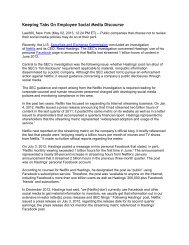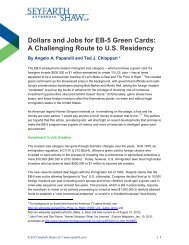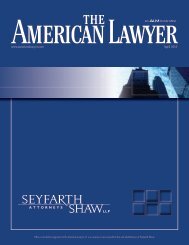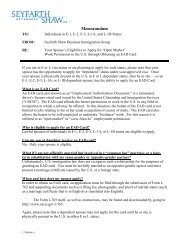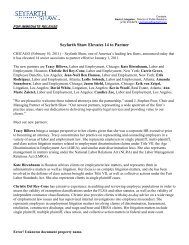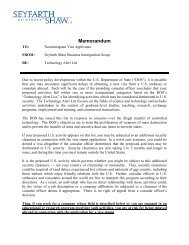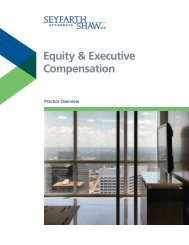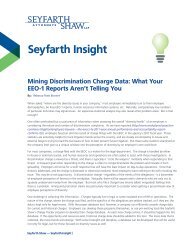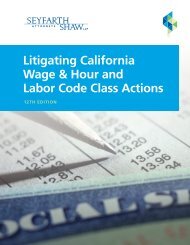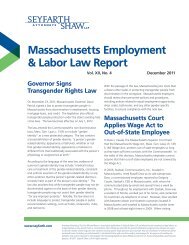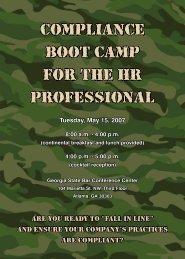ConstructionLawReport 7-06 v.2.qxp - Seyfarth Shaw LLP
ConstructionLawReport 7-06 v.2.qxp - Seyfarth Shaw LLP
ConstructionLawReport 7-06 v.2.qxp - Seyfarth Shaw LLP
You also want an ePaper? Increase the reach of your titles
YUMPU automatically turns print PDFs into web optimized ePapers that Google loves.
Construction Law Report<br />
(continued from page 1)<br />
obvious reason for this uncertainty is that Green<br />
Building requires the use of innovative systems and<br />
equipment having no significant track record for<br />
production or installation. Therefore, owners,<br />
contractors, designers and vendors alike are far less<br />
familiar with these processes and products and their<br />
comparatively novel applications. Not surprisingly,<br />
this lack of familiarity often leads to an increased risk<br />
of problems arising on the project, which may<br />
undermine the heart of the planned result.<br />
Because of the growing popularity of building<br />
green and the increased adoption of the USGBC’s<br />
LEED rating system, contractors are under<br />
pressure to become better acquainted with these<br />
concepts. Compliance with the LEED standards<br />
will be mandatory when they are made part of the<br />
construction contract. Failure to comply with a<br />
LEED system in that instance will likely result in a<br />
claim by the owner for breach of the very essence<br />
of the agreement.<br />
As with traditional construction projects, an<br />
effective risk management plan for a Green<br />
Building project should begin with a thorough<br />
review and understanding of the contract<br />
documents, which generally include the contract<br />
for construction (including any requirements or<br />
documents incorporated by reference),<br />
specifications, general and supplemental<br />
conditions, addenda and modifications.<br />
Leah Rochwarg<br />
Will the Construction Industry<br />
Catch Avian Flu?<br />
Avian Flu is emerging as a potential threat to the<br />
health of businesses and their workforces. During flu<br />
season, one sick worker absent from the jobsite may<br />
go unnoticed, and two or three may only be an<br />
inconvenience. In an Avian Flu pandemic, however,<br />
half of a workforce could fall ill and cause a<br />
construction project to come to a screeching halt.<br />
Avian Flu is a viral infection highly contagious<br />
among the bird population as infected birds<br />
spread the virus through their saliva, nasal<br />
secretions and feces. Although Avian Flu is found<br />
almost exclusively among birds, cases of human<br />
infection have also been reported.<br />
Most cases of human infection result in flu-like<br />
symptoms such as coughing, fever, extreme fatigue,<br />
sore throat, and muscle and joint aches. Some cases,<br />
however, include life-threatening symptoms such as<br />
pneumonia and severe respiratory illness. As of June<br />
6, 20<strong>06</strong>, the World Health Organization (WHO) has<br />
confirmed 128 human deaths from Avian Flu.<br />
Although the Centers for Disease Control and<br />
Prevention reports that all human cases of Avian Flu<br />
infection resulted from direct contact with poultry,<br />
scientists fear that Avian Flu may mutate and become<br />
contagious among humans. According to WHO, the<br />
danger for humans lies in mutation as well as<br />
coinfection. Should Avian Flu become contagious, a<br />
pandemic would result. Because most people have<br />
no immunity to Avian Flu, infection rates would be<br />
much higher than during seasonal epidemics of<br />
normal flu. Furthermore, the virus would inevitably<br />
spread through the workplace, resulting in high worker<br />
absenteeism.<br />
<strong>Seyfarth</strong> <strong>Shaw</strong> <strong>LLP</strong> | 2



